The summer of 2015 saw a major heatwave hit the Alps, making climbing conditions difficult and closing the Gouter hut on Mont Blanc for several weeks. Climate change is making such heatwaves more frequent and more severe. This article explains how climate change is affecting the experience of alpine climbing, and includes a trip report of an attempt to climb Mont Blanc during the recent heatwave.
Prologue: Gran Paradiso
It’s 5am, 30 July 2015, 3,800 metres above sea level. There are 3 of us on a rope, strung out on the Laveciau glacier, inching forward through a watery, bluish light. The glacier is riven with crevasses: some narrow slots, others dark, yawning voids. It’s the most broken-up, maze-like glacier I’ve ever attempted to cross.
We weave through the alleyways of ice, sometimes stepping across narrow snow-bridges, sometimes hopping across the gaps. We keep the rope between us taut, and move in sweeping arcs to keep the rope perpendicular to the crevasse lines, so as to be better able to arrest a potential fall.
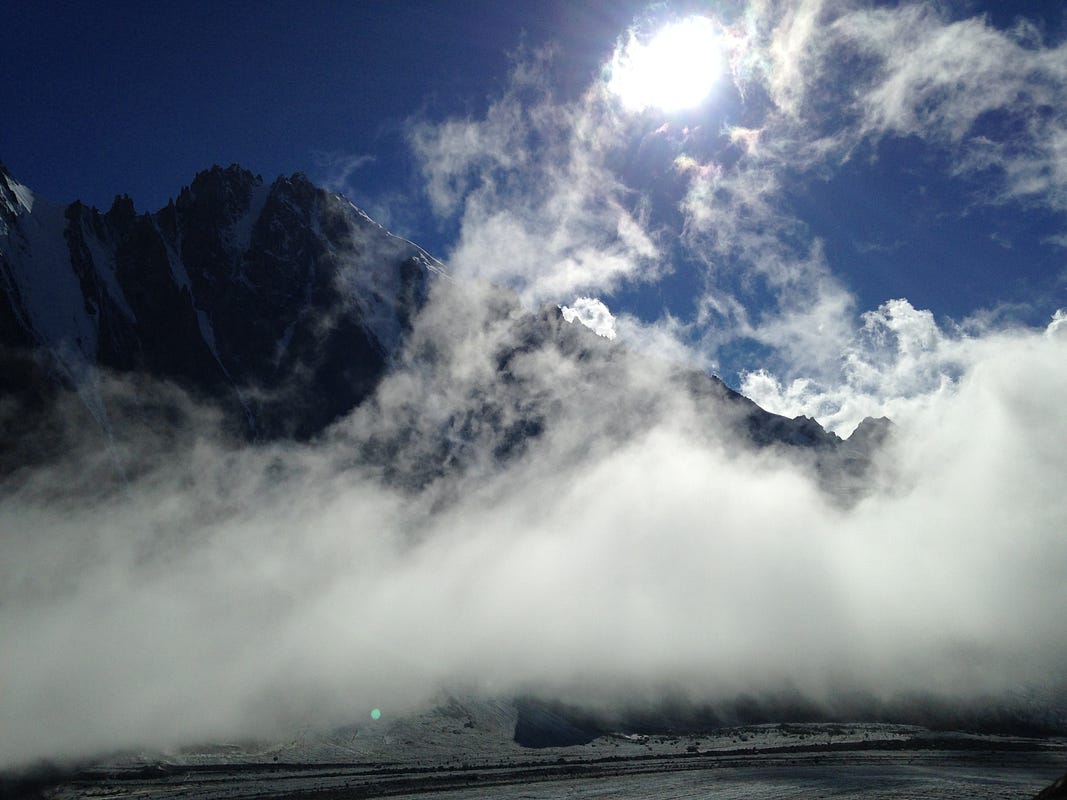

Gran Paradiso, 4,061m
The route we’re following looks nothing like the one in the guidebook. Although the book is only 7 years old, the glacier has changed radically since the guidebook was published and the old lines are no longer passable. Instead, the guardian of the mountain refuge drew us a snaking line on a postcard of the mountain to show the new way across the glacier, and it is this meandering line that we are attempting to follow.
It’s cold; colder than it has been in weeks, and this thought alone keeps me calm. A few degrees warmer and we would have abandoned the attempt. But for now the ice is firm; the snow bridges will hold. We will navigate through the ice-maze, up onto a snowy plateau, and then find our way to the summit.
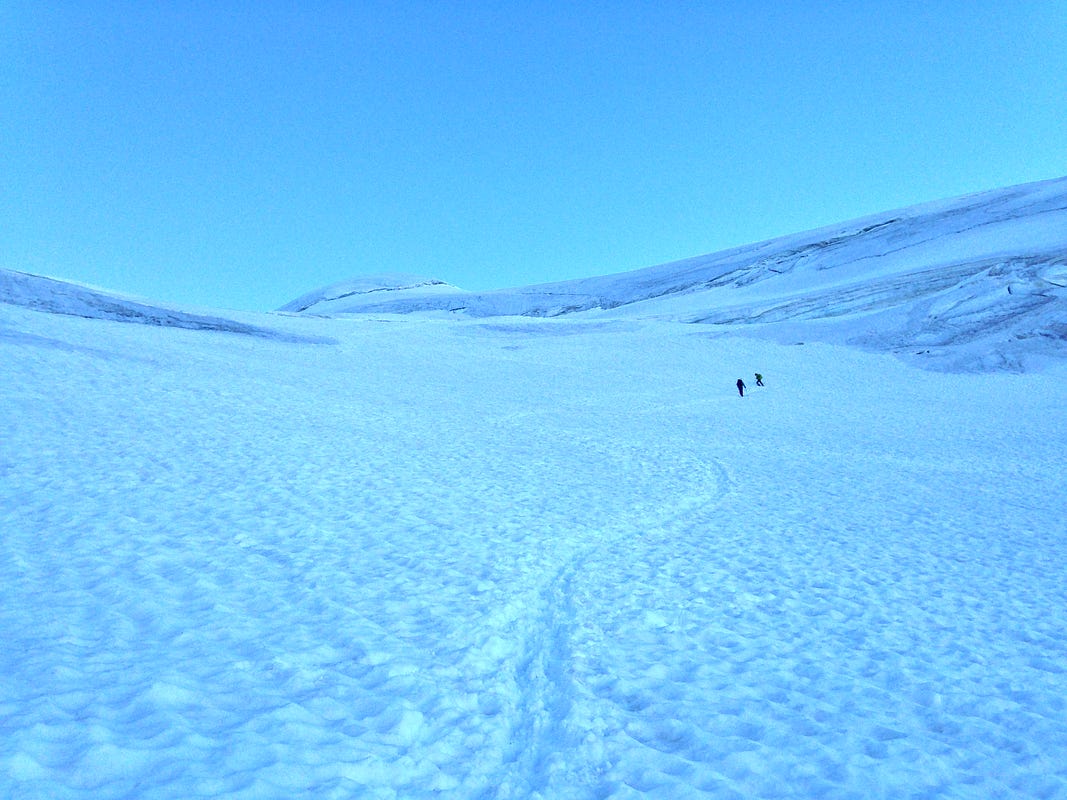
Upper Laveciau glacier
Mountains inspire.
Mountains lift the eyes up, away from the everyday.
The soaring horizons give a sense of space and of wonder.
Mountains are places of reflection, and of amazement.
They make you feel small in a big landscape.
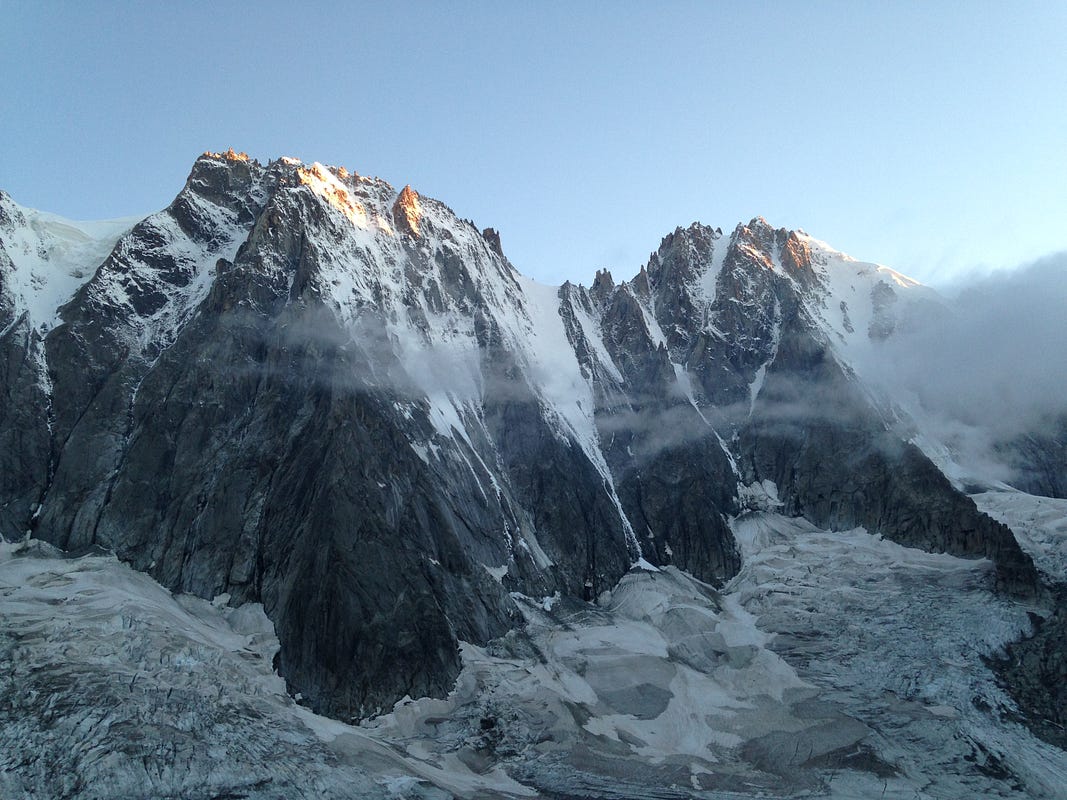
Les Droites, 4,000m
When you climb to the top of a mountain, it feels like anything is possible.
Alpinism is a strange pursuit. It doesn’t have to be fun to be fun.
You sleep in crowded mountain huts, and set off hours before the dawn. You face bitter cold and wind and searing heat, often in the same morning. The rough trails and big ascents leave your feet ragged and your knees and muscles burning. The huge exposure and objective hazards can leave your gut wrenched with fear.
Yet these travails are as nothing compared to the pure joy of being in the mountains, and the elation of a successful ascent.
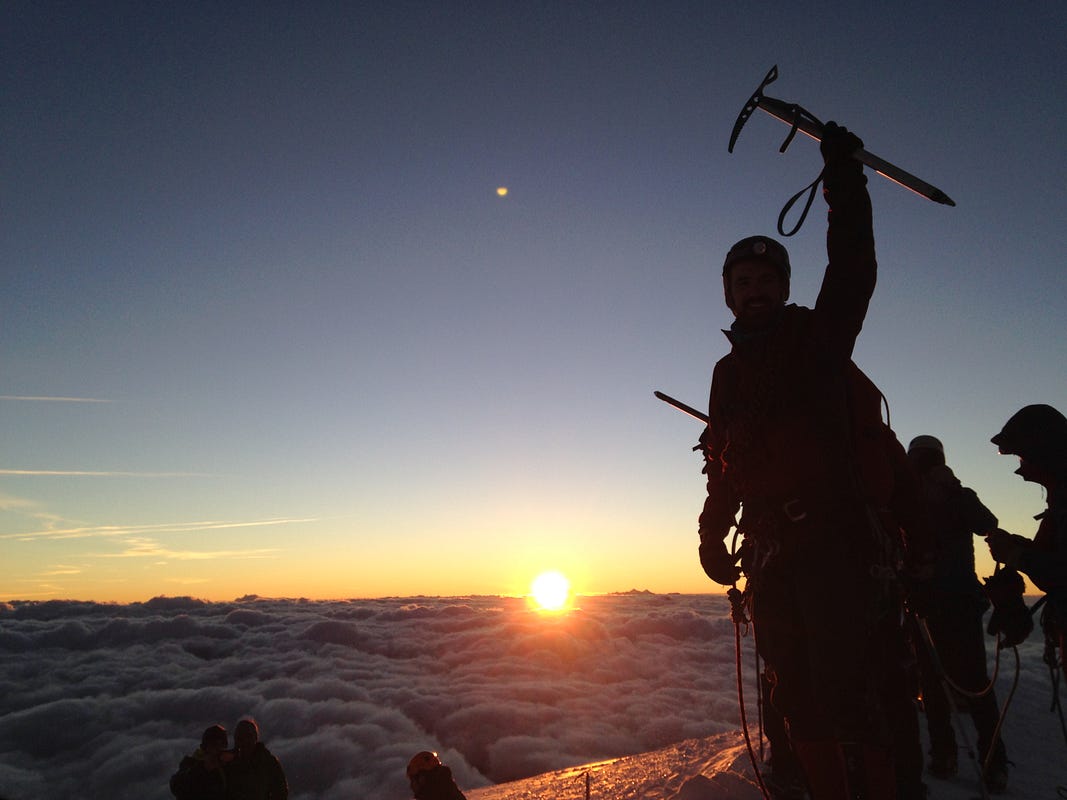
Mont Blanc summit, 4,808m
Mountains move. Glaciers flow. It’s in their nature.
The mountain landscape is one of constant change. The Himalayas are still growing, if only by millimetres per year. The Alps are slowly tumbling into the sea.
These changes have always posed risks for Alpinists, whether from rockfall or glacier crevasses. As the old adage goes, ‘geological time includes now’: there have always been hazards from the interactions between humans and landscape.

Argentiere glacier
The Alpine landscape is being transformed underneath our feet.
People have been inspired and challenged by climbing in the European Alps for over 200 years. Yet in that short timespan the Alpine landscape has been transformed by a changing climate.
Glaciers in the Alps have lost two-thirds of their mass since 1850. The 2003 heatwave alone led to the loss of 5–10% of the remaining glacier ice.
Taking the cog railway to Montenvers, we arrive at a station overlooking the Mer de Glace. When the railway was built in 1909 it was a short stroll to the glacier. These days, the glacier lies hundreds of metres below, accessed by a string of vertical ladders — ladders that need to be extended every year.

Mer de Glace from Montenvers
Climate change is changing the face of Alpine climbing.
Like generations of climbers, I was both inspired and terrified by reading the White Spider, Heinrich Harrer’s account of the first ascent of the North Face of the Eiger in July 1938. Even climbers like myself that will never climb the North Face can still reel off the terrain features from that epic ascent: the Ice Hose, the 1st, 2nd and 3rd Ice fields, the White Spider.
This summer the North Face of the Eiger is entirely snow-free. The iconic summer 1938 route is simply no longer there in any meaningful sense: its key icy passages are now just fields of loose rock. The North Face of the Eiger is now mostly only climbed in winter.

The Eiger in July 2013, still with patches of snow
Alpinism in a changing climate means adapting to new difficulties
This is the new reality of Alpinism in a changing climate. The challenge of climbing the mountains is matched by the challenges posed by the dramatic changes to the mountains themselves.
The summer of 2015 has seen an extraordinary heatwave, with record-breaking temperatures in the valleys and with the freezing level above 3,500 metres for days or weeks on end. It follows the extreme heatwave of 2003, thought at the time to be a once-in-a-generation event. Colder, wetter years still happen (like 2014), but the heatwaves are becoming more frequent and more sustained.
This creates difficult conditions for alpine climbing. Glacial retreat, moraine collapse, crevasses, open bergschrunds, seracs, ice, rockfall and flooding risk make staying safe while accessing and climbing alpine routes considerably harder.

Weather station at Argentiere refuge
The challenges of climate change (1): Glacial retreat
The extraordinary disappearance of glacial mass in the Alps not only changes the views, it also makes Alpine travel more complicated.
The mountain huts and trails were built when the glaciers were much larger than they are now. As the glaciers retreat, they leave behind granite walls polished smooth by the rock and ice, or unstable ridges of glacial rubble — both difficult to climb.
Access to many of the huts now requires ascending ladders that have been bolted into the rock, or steep paths up unstable ground.
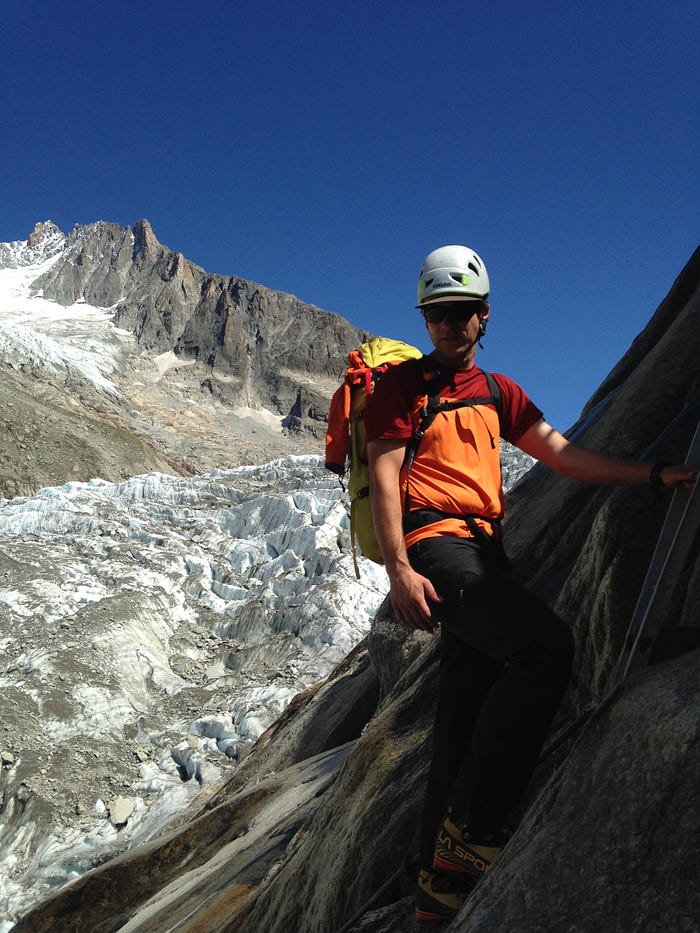
Ascending a ladder en route to the Argentiere refuge
The challenges of climate change (2): Moraine collapse
As glaciers flow they carve through the surrounding rock and pick up piles of debris, called moraines. Sometimes moraines can be as big as hills.
But as the glaciers move, so do the moraines — sometimes piling up further, sometimes collapsing.
We set off one morning to climb on a granite cliff rising up off the Mer de Glace glacier. We were surprised to find that the collapse of the moraine at the start of the route means that the climb is now 3 rope lengths longer than it appeared in our guidebook — with the first pitch ascending through an actual waterfall before the first decent belay could be found.
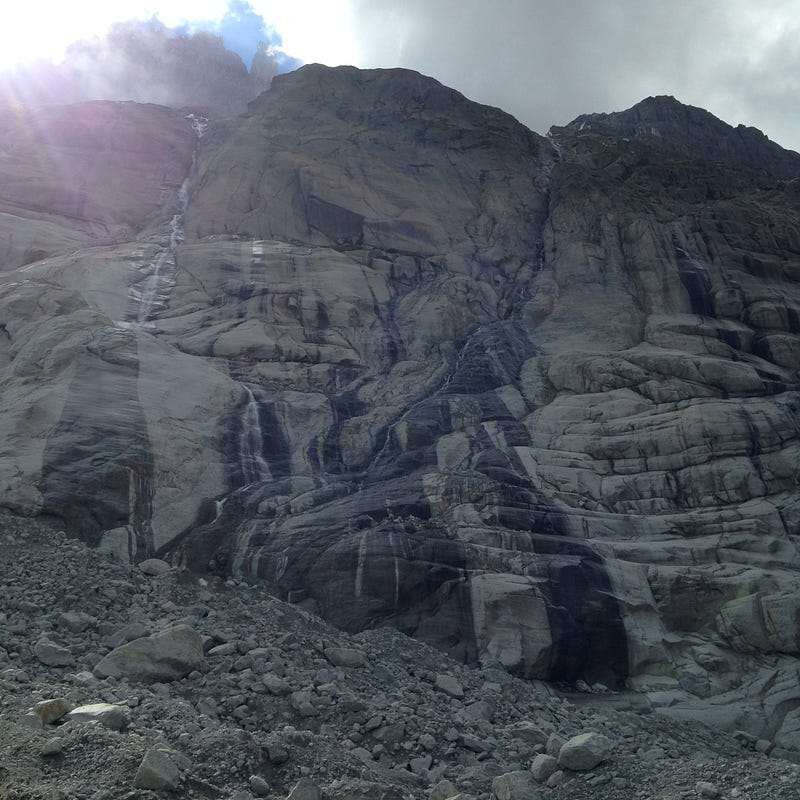
Pilier des Rhodos-Dindons on the lower slabs of the Envers des Aiguilles
The challenges of climate change (3): Crevasses
As glaciers flow they crack under pressure, opening up crevasses. Just like rivers are at theirs most turbulent where they are steepest or turn suddenly, glaciers tend to be most crevassed where they are under most stress.
In a snowy or cold season the crevasses can remain covered in snow and the climber will be blissfully unaware of their presence unless s/he is unlucky enough to fall through a snow bridge into one. A hot or a dry season melts off the snow. This makes the crevasses easier to spot, but can also make a crevassed glacier impossible to cross — as you’re left with a maze of broken-up ice with deep slots all around.
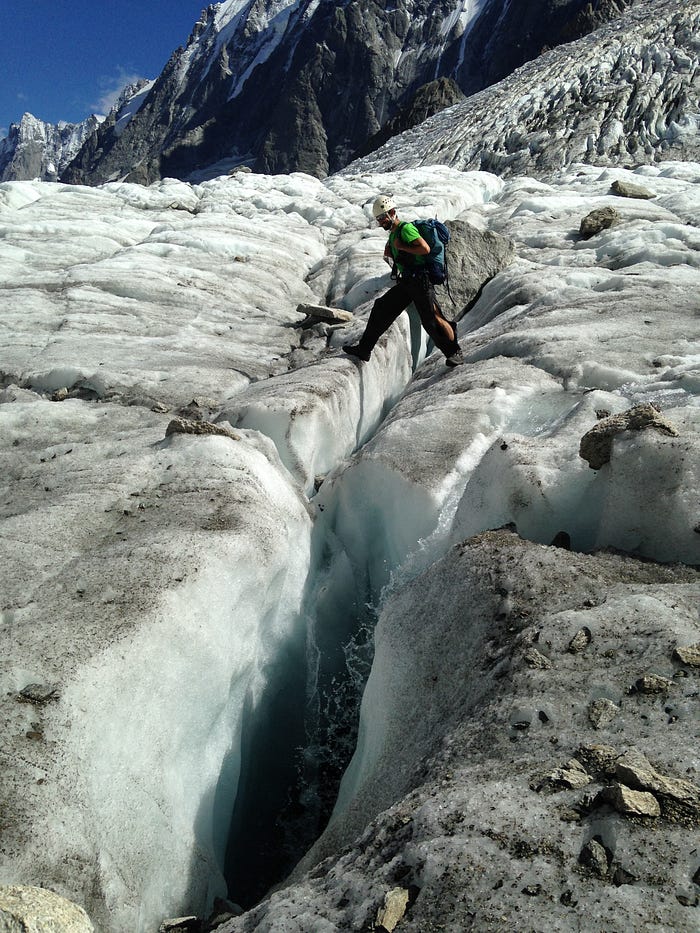
Argentiere glacier
The challenges of climate change (4): Bergschrunds
Bergschrunds (or rimayes) are gaps that form where glaciers pull away from the rock as they flow downhill.
In a snowy year, on many routes the bergschrund will be mostly filled with snow, or crossable via a snow bridge, until late in the season.
This year, the heatwave meant that open bergschrunds blocked access to dozens of popular routes in the Alps.
In the picture below, climbers are descending an aluminium ladder that local guides fixed across the bergschrund on Gran Paradiso. It’s nerve-wracking to climb across wearing crampons, but there’s no other way down.
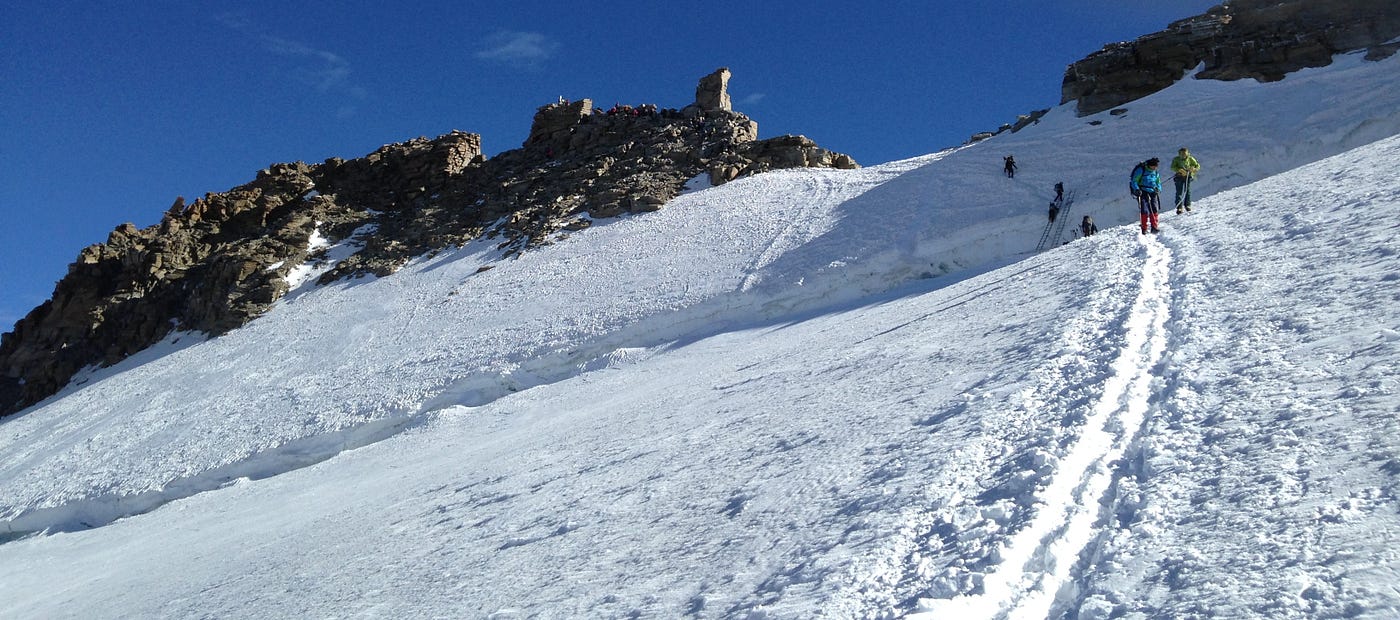
Crossing the bergschrund on Gran Paradiso
The challenges of climate change (5): Seracs
Seracs are ice cliffs that form on steep glaciers. They can be as tall as buildings, but also have a tendency to calve off without warning.
You don’t want to be anywhere underneath them when that happens.
Heatwaves and glacial retreat break up the glaciers more quickly and make serac falls even more of a risk, but serac collapses can happen even when it’s cold.
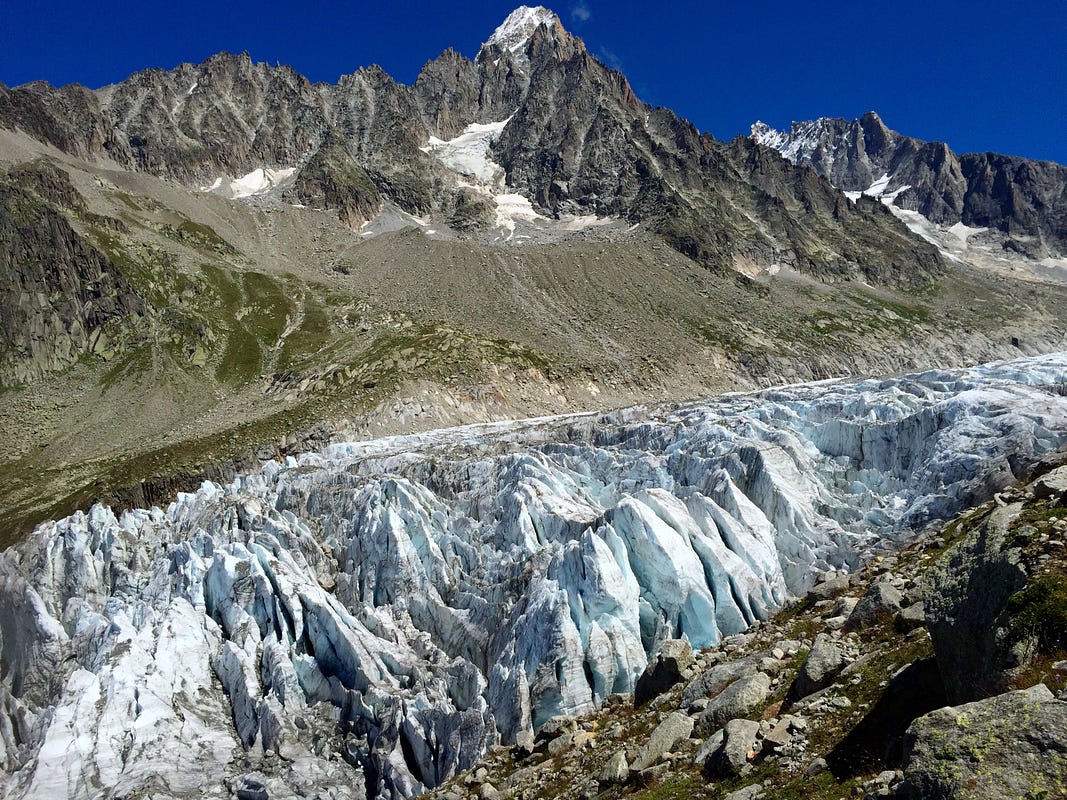
Lower Argentiere glacier
The challenges of climate change (6): Ice
It may seem counterintuitive, but one of the effects of the heatwave is to make routes more icy and thus more difficult to climb.
Compact snow (called neve) is relatively easy to climb on, even when it is steep: crampons and ice axes stick in it well. But the heat can melt away the snow, leaving rock-hard glacier ice that crampons just won’t kick in to. Alternatively, the heat of the sun can melt the top layer of the snow into running water, which refreezes overnight into a slick layer of hard ice.
Either way, it can turn an easy route into an ordeal.
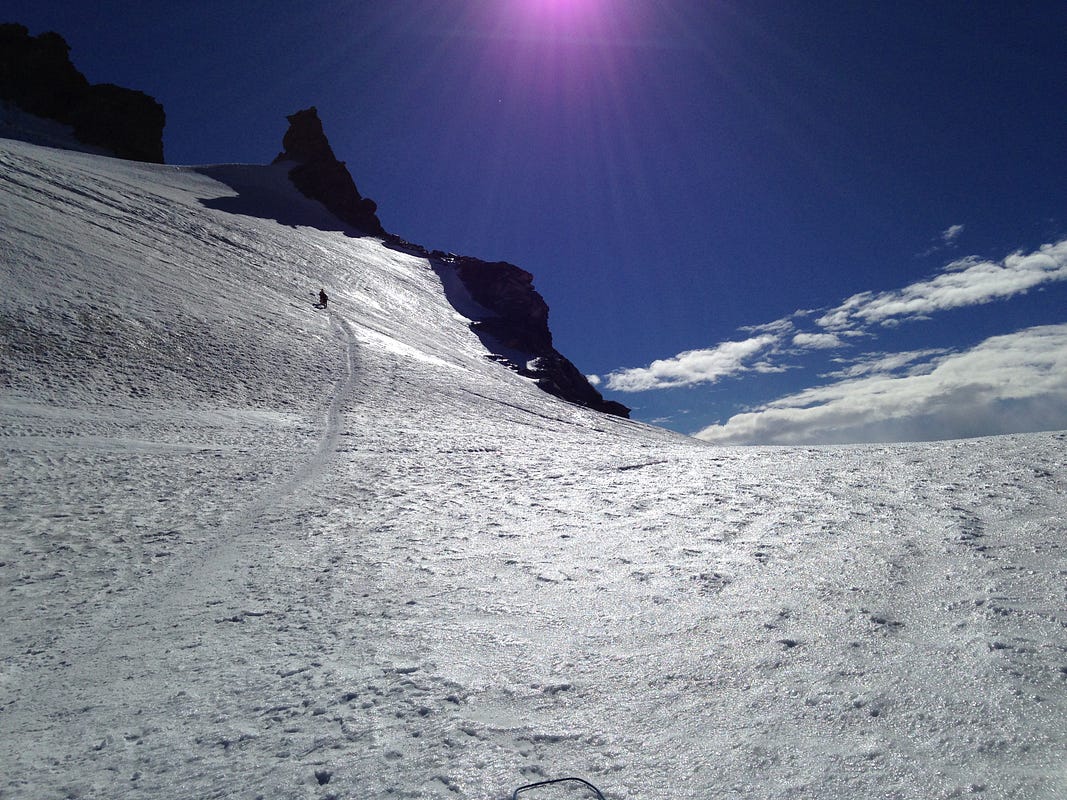
Gran Paradiso descent
The challenges of climate change (7): Rockfall
Ice isn’t just there to climb. It’s what holds the landscape together. Literally. Above 3,500m or so, permafrost and permanent snow and ice fields play a critical role in slope stability.
As the ice melts, rocks that have previously been frozen in place become dislodged, and can tumble down slopes threatening climbers and walkers below.
In the picture below, the Grand Couloir on Mont Blanc has been likened to a bowling alley, as in the mid-day sun rocks keep ricocheting down. Climbers take shelter before sprinting across as soon as the sound of the rocks goes quiet.

Crossing the Grand Couloir
The challenges of climate change (8): Collapsing mountains
Sometimes ‘rockfall’ is a matter of a few stones tumbling down a hillside. But the Alps have also seen an increasing number of massive rockslides, with the collapse of entire cliffs. As the permafrost disappears and heat expands the rock, whole ridges and pinnacles can become detached and crash into the valleys below.
On our descent from Mont Blanc, a large rockslide occurred across the valley, releasing huge clouds of dust. We can only hope no one was below.
In 2005, the legendary Bonnati Pillar on the Dru simply collapsed, releasing 265,000 cubic metres of rock and erasing some of the most famous rock climbs in the region.
This summer, routes on both Mont Blanc and the Matterhorn have been closed due to fears of rockfall.
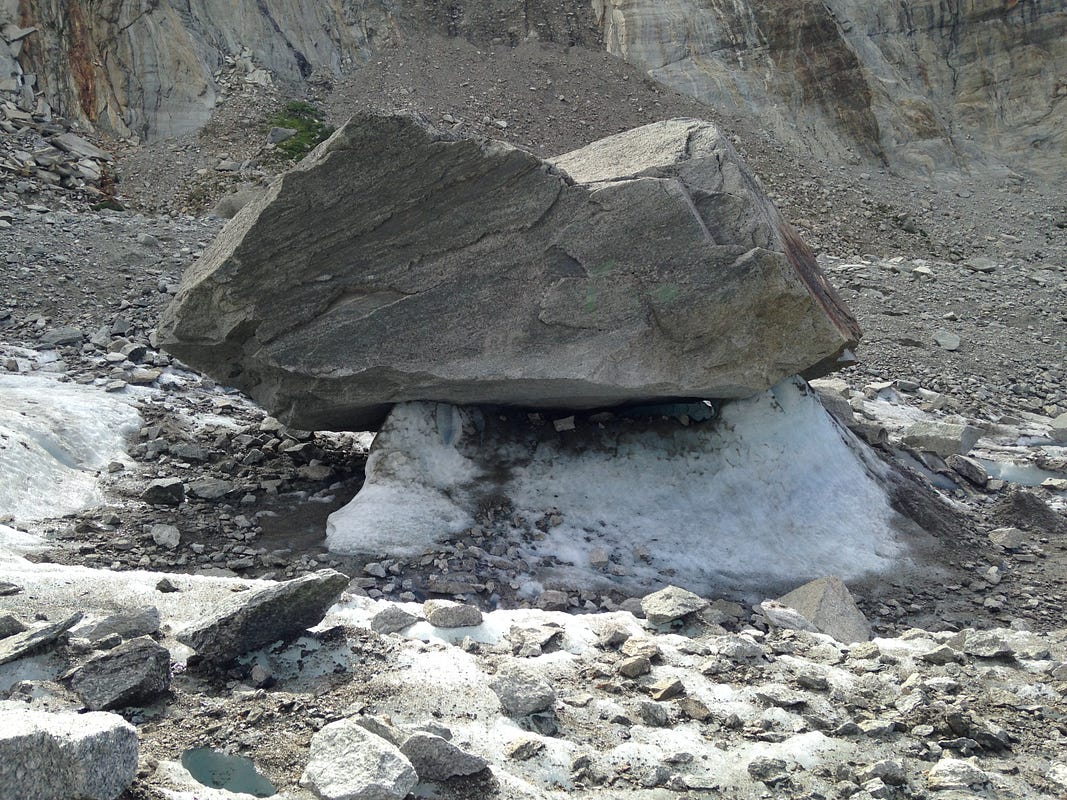
A small rockfall in Alpine terms
The challenges of climate change (9): Flash flooding
Melting snow and ice creates water, in significant quantities. Often this flows off directly into streams and rivers. High water can be harder to cross.
Sometimes, however, the melt water pools up in pockets within the glacier. A heatwave or summer downpour can cause these ‘poches d’eau’ to burst and release floods of water down narrow mountain valleys.
A week before we climbed this fine granite wall in the La Berarde valley, the rupture of a poche d’eau triggered a flash flood that destroyed multiple bridges and left behind piles of debris.
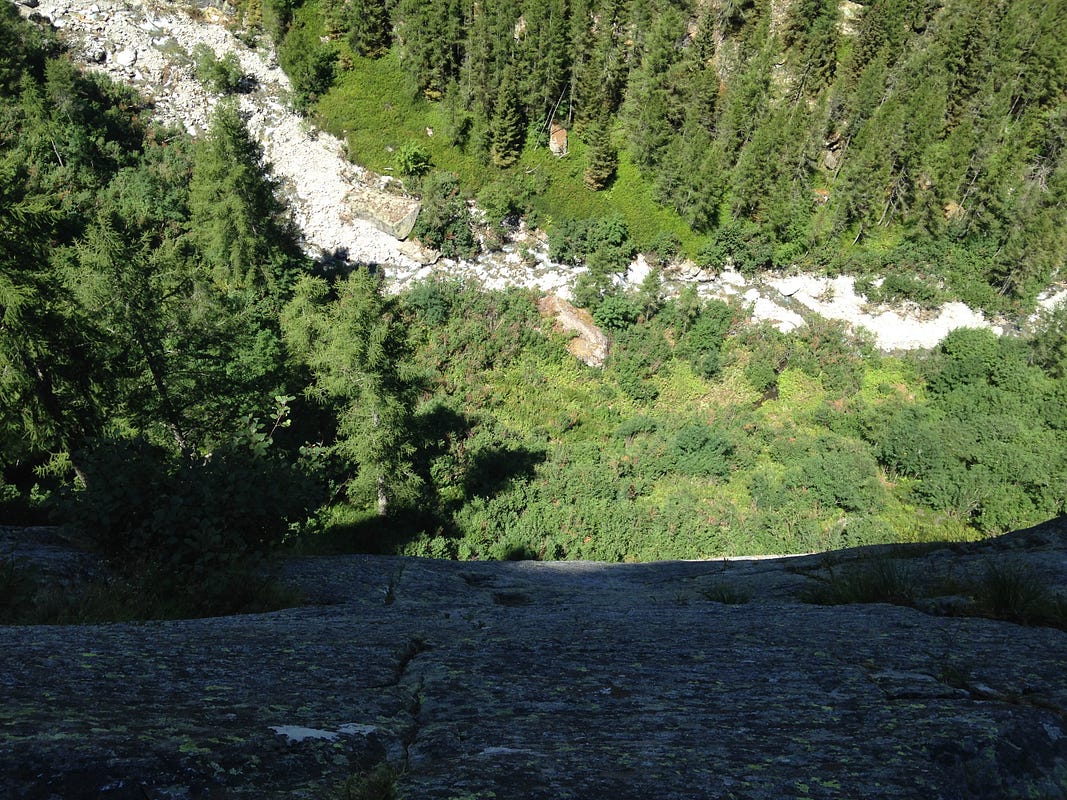
Climbing L’ile aux Razmokets above La Berarde valley
An ascent of Mont Blanc
Mont Blanc haunts the Alpinist. From summits across the Alps, on a clear day the snowy mass of Mont Blanc will be seen skulking on the horizon, as if waiting its turn to be climbed.
I had resolved to climb Mont Blanc a year ago, watching the sun set over its ridges from the balcony of a friend’s apartment in Geneva. The trip had been months in preparation. Yet as spring turned to summer and the heatwave set in, the likelihood of success seemed small.
There are four routes at a manageable grade up the mountain and each one was being battered by the heat. The Grand Mulets route (the normal way up for much of the 20th century) and the Italian normal route were blocked by impassable crevasse fields. The Trois Monts route had a difficult bergschrund and an ‘incredibly exposed icy traverse’ across Mont Maudit. The normal ‘Gouter’ route was a no-go because of rockfall risk in the Grand Couloir, and the Gouter refuge was closed by municipal decree because of the danger.

Mont Blanc bosses ridge, 4,808m
It wasn’t looking good for routes on other mountains either. On arrival in Chamonix we visited the Office de Haute Montagne. It’s an extraordinary resource for climbers, where guides collate reports of mountain conditions and can advise on planned itineraries. But this time it felt like I was in the Monty Python ‘cheese shop’ sketch: I named nearly every alpine snow and mixed route I had ever of, only to be told each one was out of condition due to open bergscrunds, crevassed glaciers, bare ice or rockfall risk. Only the rock routes and a handful of glacier climbs were described as possible.
We climbed some rocks, ate some cheese, drank some wine. We were lucky. It got colder, lowering the rockfall risk, and the Gouter hut on Mont Blanc reopened.
It was game on for Mont Blanc.
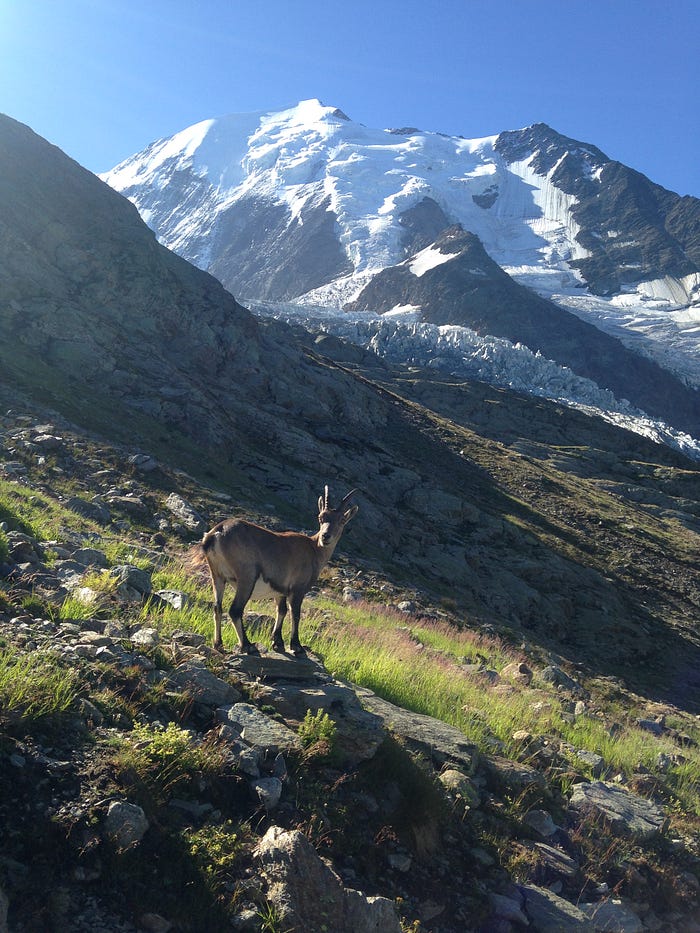
Chamois and the Aiguille de Bionnassay, 4,052m
First, however, it was a question of getting there. Climate change is affecting not only the alpine routes but also the mountain infrastructure. Normally the Gouter hut is accessed via a cog railway up to Nid d’Aigle, 1,400 metres below. But rockfalls triggered by the heatwave damaged the tracks, and the railway was closed for repair. This meant a 2,000 metre ascent just to get to the hut, and well over 3,000 metres of knee-wrecking descent to get back down from the summit.
We marched up the railway tracks, across talus fields, up a ridge and across theTete Rousse glacier. We arrived at the Grand Couloir just before noon, with the sun only just hitting the loose screes of rock. We stand and stare: every couple of minutes a small shower of stones clatters down. The couloir goes quiet; and Bryn crosses first while I watch for rockfall. Then it’s my turn: I start to cross, only to hear shouts and the clatter of rock. I retreat to safety, and watch a rock the size of a toaster sail past soundlessly overhead. The couloir goes quiet again. I cross, quickly, and we make our way up the rocky ridge up to the glacier and the safety of the hut.
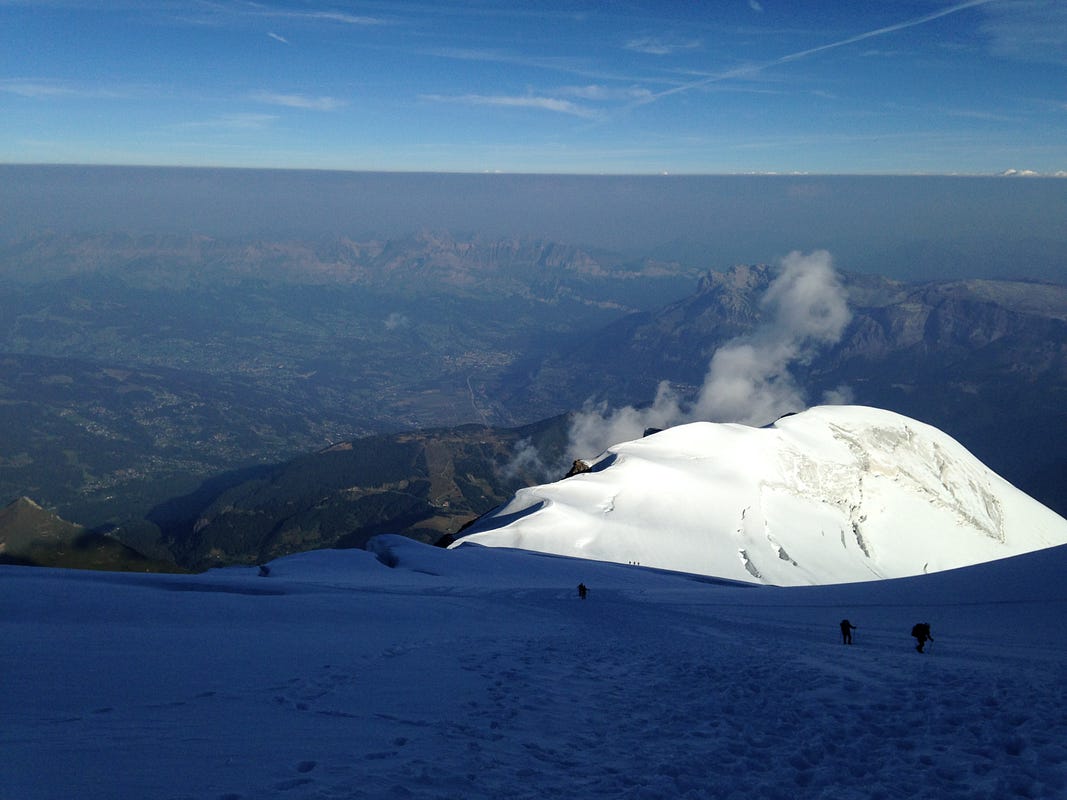
Looking down from above the Gouter hut: our starting point is 3,000 metres below
2:30am, 6 August 2015
The glacier is dark but the way ahead is dotted with shining lights. It feels somehow primeval. There are dozens of us, all strung out in single file, not speaking, headtorches burning, heads down, marching up to the highest point in all the land. It’s a big mountain: soon enough the crowds thin out.
The dark sky begins to soften. The ridge narrows into a sharp, dragonbacked line. ‘If I fall into France, you jump into Italy’… At this altitude, breathing is harder work and I set a slow but steady pace. It’s just one foot in front of the other.

Summit slopes of Mont Blanc
The narrow ridge feels like it could continue forever. But without warning, the angle of the slope suddenly eases.
We’re on the summit of Mont Blanc, 4,808 metres above sea-level, high above a sea of clouds, glowing bright pink as the sun edges its way over the horizon.
Despite the thin air I can’t help but laugh. It’s wonderful to be here.
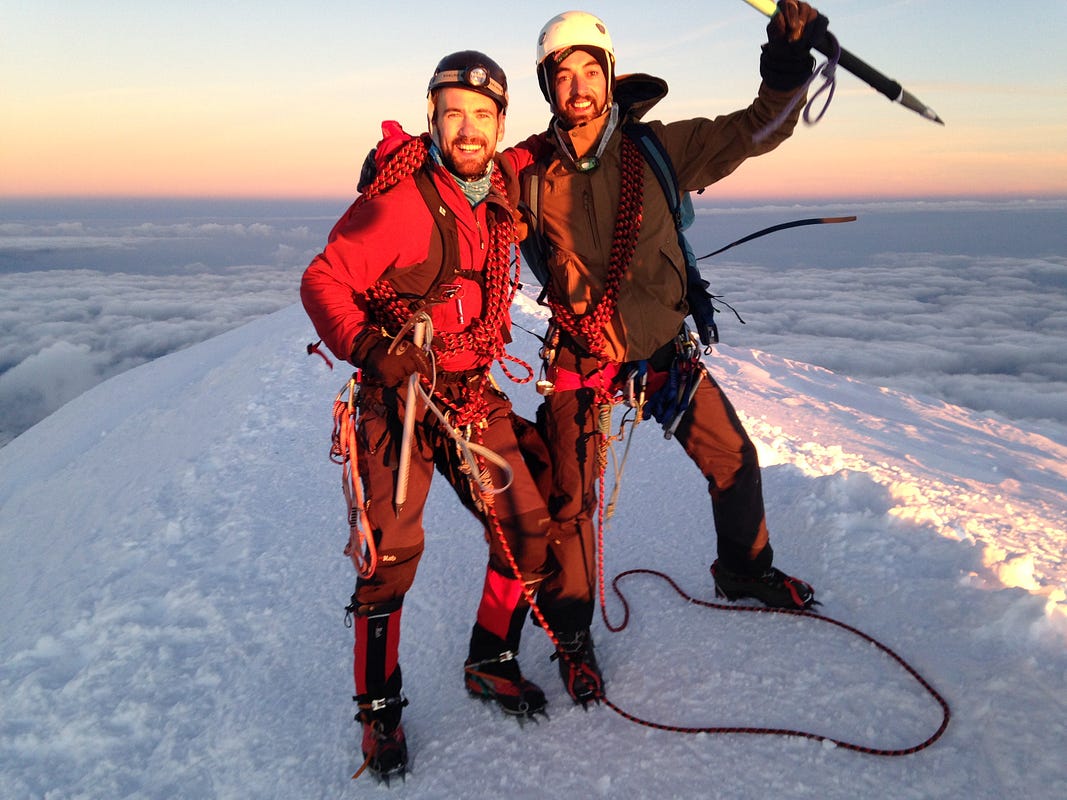
Jonathan Gaventa and Bryn Kewley on Mont Blanc summit
The descent was long, and hard on the joints. I kept a hard pace in hopes of crossing the Grand Couloir before the sun hit. We got there in time: the Couloir was in shade, with none of the stonefall of the previous day — but the heat of the day was only beginning.
Later, we learned that rising temperatures meant that the Gouter Hut had been closed by the authorities once more just after we left, again from fears of rockfall. Helicopters evacuated the remaining climbers. If we had known, we could have got a free lift down.
The municipal authorities were in no doubt to the cause of the deteriorating mountain conditions. The official notice announcing the hut closure stated:
“The climate changes that we are now facing require that each of us changes his or her behaviour”.
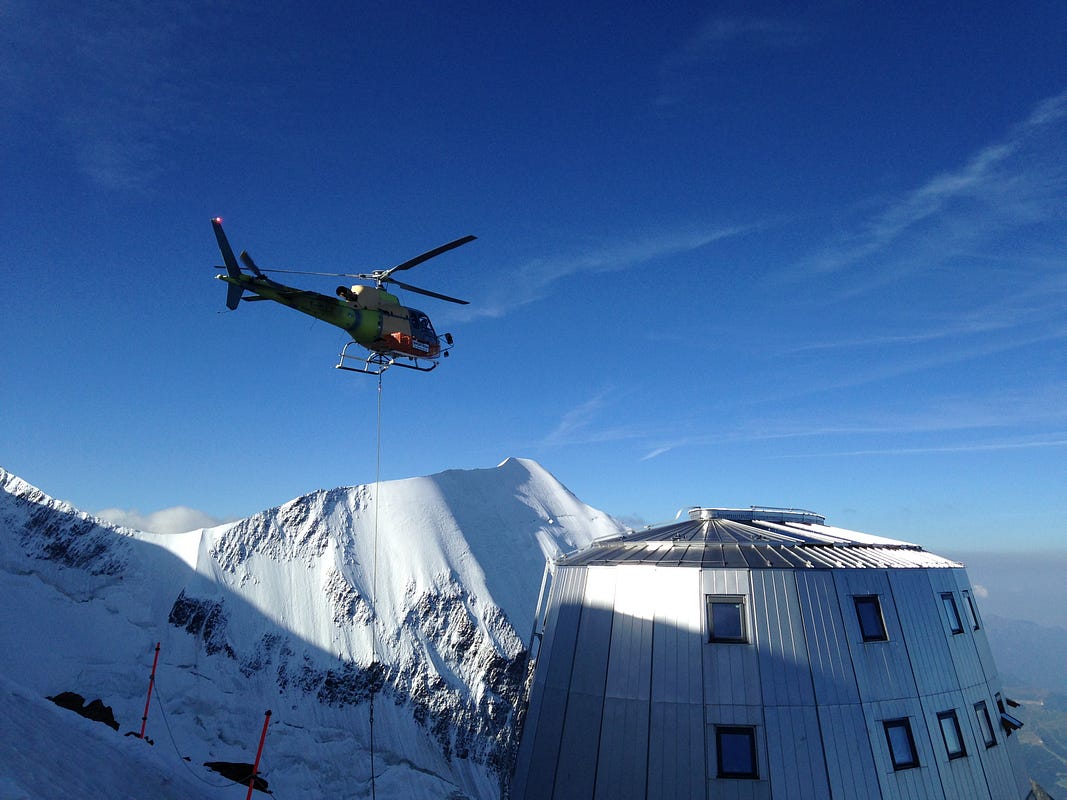
Gouter refuge
Post-script: The Ice and the Canary
I turned 35 on my trip to the Alps. I was born in 1980. The world has changed in the course of my own lifetime. As observed, the Alpine landscape has changed considerably. In my lifetime we have also seen a clear recognition of climate change not just in science but also in the political and public spheres, and the early stirrings of what may turn out to be one of the largest self-directed global economic transformations in history.
Measured in terms of my own lifetime, we’re now halfway to 2050. Countless modelling studies use 2050 as a target date for changes we need to achieve in the future. To have a good chance of keeping climate change within 2 degrees of the pre-industrial average, by the time we hit 2050 the world needs to have cut its emissions in half. By 2050 Europe needs to have decarbonised pretty much its entire energy system.
35 more years. 2050 no longer seems so far off.
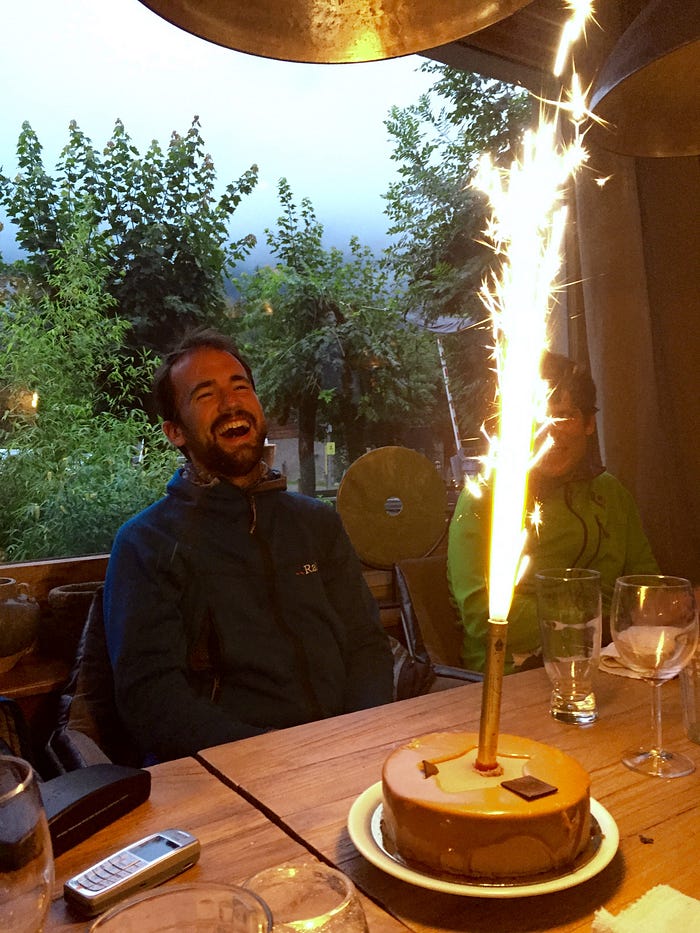
Birthday dinner
Other modelling studies tell us about the world we can expect in 2050 or 2100 in a changing climate. Heat, drought, storms, floods, disease all become more prevalent. From the current comfort of a temperate climate, these impacts can sometimes feel somewhat distant, somewhat hypothetical.
Models tell us what may happen in future. The mountains are telling us what is happening now, before our own eyes, underneath the spikes on our own feet.
The ice of the Alps is our own canary in the coal mine. The ice is sensitive to the changes that ultimately threaten us all, but are currently barely perceptible in our everyday lives. The ice is giving us an early warning of things to come.
The canary is dying. It’s a signal we need to down tools and get out.

En route to Mont Blanc
Mountains inspire. When you climb to the top it feels like anything is possible.
The mountains are changing, quickly.
It’s time for us to change too.
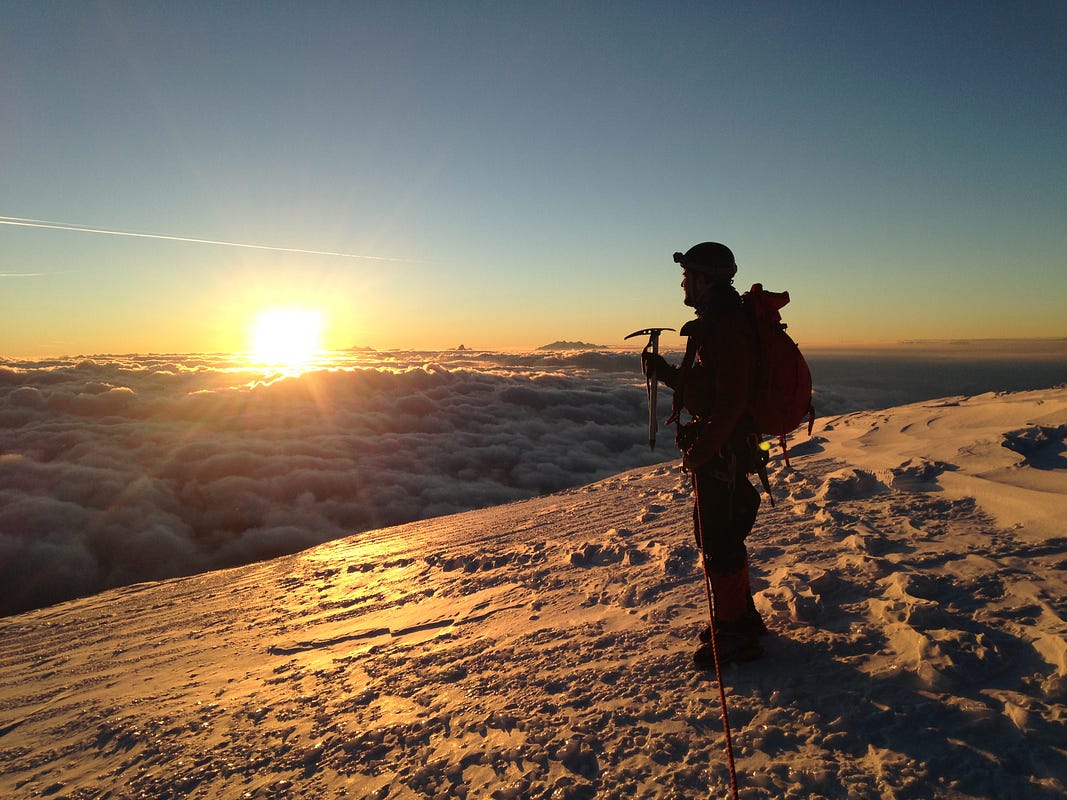
Mont Blanc summit
Jonathan Gaventa is an average but enthusiastic Alpinist, and also a Director at E3G, a non-profit environmental organisation.
Thanks go to Bryn Kewley, Simon Middleton, Jacob Gaventa, Eryka Thorley and the Brixton Climbers Club.


